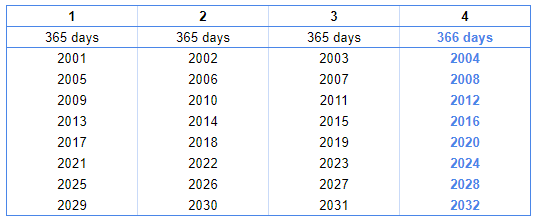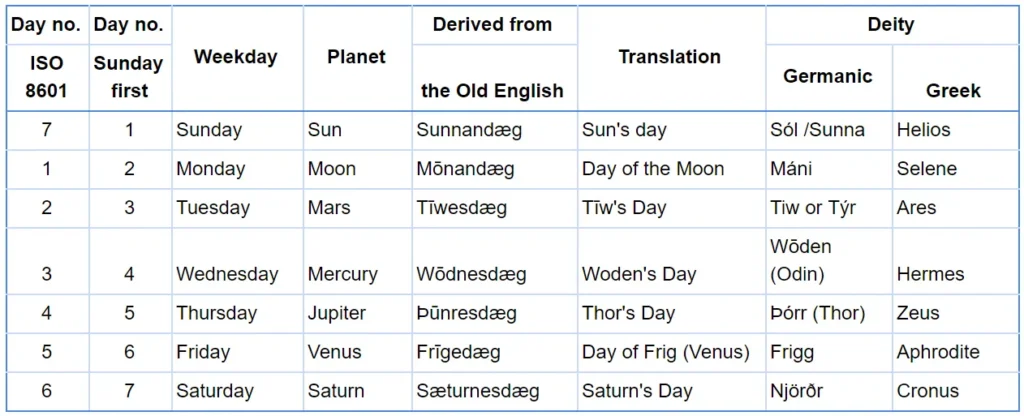What we call “day” (in this context)
In the context of this article, when we say day, we are referring to the 24-hour interval in which the earth makes a complete rotation about its axis. This interval includes a day and a night if we separate them in the intervals in which it is light (day) and in which it is dark (night).
Who determined the calendar year of 365/366 days?
The Gregorian Calendar used today was introduced in 1582. However, its history dates back to Roman times.
The Roman Calendar
In the Roman Calendar, ordinary years had 355 days. Systematically, years of 377 or 378 days should have been interspersed between them, to maintain alignment with the tropical year. However, often, dignitaries avoided doing so, or did so for 2 consecutive years (for political reasons, for example, to extend their political mandates).
The Julian Calendar
To end these disturbances, in the year 46 BC, Julius Caesar proposed that from January 1, 45 BC, a new version of the Roman Calendar be applied. The Greek astronomer Sosigenes of Alexandria advised him on this and designed the calendar reform.
To facilitate the adoption of the new calendar, the year 46 BC was extended several times and lasted 445 days. This had to be done to align the beginning of the tropical year with January 1, 45 BC. Because ordinary citizens usually had no idea what the current date was, the year 46 BC has been called the “last year of confusion.”
In time, however, the days of the year shifted due to certain astronomical events, as the Julian Calendar estimated the solar year to be 11 minutes and 14 seconds shorter than it actually is.
The Gregorian Calendar
In 1582, Pope Gregory XIII hired the German Jesuit and astronomer Christopher Clavius to solve this problem. Following Clavius’s research and discoveries, the Gregorian Calendar was created and put into practice immediately.
The 10 days lost over time due to the gap between the solar year and the Julian Calendar were recovered when it was decreed that after October 4, 1582, the next day would be October 15.
From then on, we have used this calendar. The only adjustment is the one that was made in the 20th century, stating that if a year is divisible by 400, it would not be considered a Leap Year. This was decided because, according to the current Gregorian Calendar, one more day should be added once every 3,323 years.
How many days are actually in a year?
To answer this question, we need to look into the field of astronomy.
The time interval in which the earth makes a complete rotation around the Sun is called the solar year and it is 365.242199 days long—in other words, 365 days 5 hours 48 minutes and 46 seconds.
Because this astronomical event does not happen in an exact unit of time, conventions have been established regarding the number of days in a calendar year.
The Gregorian Calendar introduced in 1582 was accepted and still functions as a worldwide convention. It states that for three consecutive years, only 365 days will be taken into account, while in the fourth year, the remaining difference will be added up (4 x 0.25 days). This fourth year will have 366 days.
For example, the years 2017, 2018, and 2019 had 365 days, while 2020 had 366 days. Respecting the same rule, 2021, 2022, and 2023 will each have 365 days, and 2024 will have 366 days.
All years that have 366 days are called Leap Years, and the “extra” day is February 29. Therefore, this day will exist only once every four years.
Leap Day
As we have seen, every four years, a day is added to our calendar to synchronize the solar year with the calendar year. According to this convention, the added day is February 29 and because it is added in a Leap Year, in turn, it is called a Leap Day.
In the three normal years, February has 28 days, while in the fourth year, it has 29 days.
Out of 7.7 billion people worldwide, about 5 million were born on February 29. Among them are the following celebrities:
- Tony Robbins – Motivational speaker and life coach, February 29, 1960
- Cullen Jones – American competition swimmer, 1984
- Jessie T. Usher – Actor, 1992
- Antonio Sabato, Jr. – supermodel, actor, and fitness author, 1972

Fun fact
Superman’s “birthday” is celebrated on February 29.
The age of those who are born on a Leap Day
People born on February 29 may celebrate their birthday on their real birth-day only once every four years, but they grow old just like the rest of us.
As 29 comes after 28, legally speaking, the age is considered to be fulfilled with the passing of February 28th. Therefore, on a “normal” year, this date will be March 1.
The number of days in a month
The number of days differs from month to month. The basic idea is that the lunar calendar reflects the time interval in which the Moon makes a complete orbit around the Earth, which is 29.53 days. The ancient Greek month started once the first segment of the new moon appeared. But the Moon’s motion in its orbit is not constant, so it was very difficult to predict when one calendar month would end and the next would begin. Therefore, the number of days in a calendar month was not easy to determine.
Subsequently, the earliest ancient Roman calendars used months with 29 or 30 days, and as we have seen, the calendars were reformed more than once. In the end, the number of days that Julius Caesar set in 46 BC has remained unchanged to this day.
We still use this calendar template, which has 31 days for seven months, 30 days for four months, and 28 (or 29 in a Leap Year) days for February.

FUN FACT
There is an assumption that August initially had 30 days, but because:
- July was named after Julius Caesar (formerly Quintilis) and had 31 days, and
- The month of August was named in honor of Augustus Caesar, then
- One day was taken from February and allocated to August, so that it also has 31 days, just like July.
All this was done to give both Caesars the same number of days in the months named after them.
The number of days in a week
There are seven days a week. Why this number, and not more or less? Simply because this convention has been used since antiquity.
Unlike the day, month, or year, this seven-day time interval does not correspond to any astral event.
However, the seven days of the week still seem to be related to astrological events. The Babylonians celebrated “holy days” on certain days according to the new moon (the 7th, 14th, 21st, and 28th) and also the full moon (sabbath).

An interesting fact about the seven-day week
Between 2144-2124 BC, Gudea, a ruler of a city-state in southern Mesopotamia, built a seven-room temple and organized a seven-day festival that seems to have been dedicated to the Babylonian creation myth (recorded on seven clay tablets). This remains the earliest evidence of the astrological significance of a seven-day week.
On what day does the week start?
From ancient times, there have been differences in the days on which the week begins. To this day, in some countries, the week begins on Sunday, while in others it begins on Saturday.
For example, in North America, Sunday is the first day of the week, while modern Western culture refers to Monday as the beginning of the workweek. In Europe, Monday is considered the first day of the week.The International Organization for Standardization, which provides common standards among nations, prescribed in ISO 8601 that Monday is the first day of the week. This was done to remove doubts that can result from the various day–date conventions, cultures, and time zones that impact a global operation.
The names of the days
Babylonians, just like the ancient Greek and Roman civilizations, recognized seven planets in the sky. These are the ones visible to the naked eye, namely, the Sun and the Moon, as well as Mars, Mercury, Jupiter, Venus, and Saturn. Therefore, they named the days of the week after these objects.
It is worth mentioning that the order of these planets, the way they move in the sky, and their distance from the earth has no relevance with regard to the order in which the days of the week were named.
Although in many cultures the days of the week are named after these planets, there are also cultures in which the days of the week are named after certain deities.

Interesting fact: The “alchemy” of the seven planets
Alchemists have associated each of the seven planets after which the days of the week are named with different metals and vital organs over which they supposedly hold dominion.
The associations are the following:
| Planet | Metal | Organ |
|---|---|---|
| Sun | Gold | Heart |
| Moon | Silver | Brain |
| Mars | Iron | Gallbladder |
| Mercury | Mercury | Lungs |
| Jupiter | Tin | Liver |
| Venus | Copper | Kidneys |
| Saturn | Lead | Spleen |
Nowadays, we are familiar with similar associations in the field of astrology. This pseudoscience claims that it is possible to predict the course of affairs in our lives by studying the movements of astral objects.
Astrology makes these associations between the supposed influences that the planets have on us as well as the characteristics of the deities that govern those planets. Thus, regarding the seven days of the week, astrological theories were issued according to which:
Saturday is associated with Saturn, a planet that represents authority, old age, and structures.
Sunday is ruled by the Sun and influences us through energy, joy, and creativity;
Monday makes us feel “moody” because it is ruled by the Moon and its phase changes;
Tuesday, which is ruled by Mars and the god of war, will make us feel proactive, courageous, and brave;
Wednesday is associated with rational thinking, communication, and a quick, clever wit due to the influence of planet Mercury and Hermes (a deity who has winged sandals);
Thursday, ruled by Jupiter, seems to be the day that can help us reach for high ideals and principles;
Friday is ruled by Venus (the planet and also the deity), which is why it seems to give us love, harmony, money, and possessions;
Weekday and weekend
Regarding professional activity, it was established that out of the seven days of a week, five of them would be worked on, while the other two would be allocated to professional rest.
Although this convention is not universally valid, it is generally considered to be:
- working days (weekdays): Monday, Tuesday, Wednesday, Thursday, and Friday;
- rest days (weekend days): Saturday and Sunday
Depending on the circumstances, sometimes labor is done on Saturdays and Sundays, and the professional rest is taken on two other days of the week. However, in general, when we talk about weekdays, we mean the days listed above.
Saturdays and Sundays have been considered days of religious worship and rest since antiquity. However, this is not the same in all religions. For example, Saturday is a day of religious celebration (Sabbath) for Jews, Seventh-Day Adventists, Messianics, and Seventh-Day Baptists. Instead, for the Roman Catholic and Eastern Orthodox churches, Sunday is the Lord’s day.

An interesting fact about Sunday as a legal holiday
Sunday (Day of the Sun/dies Solis) as a legal holiday was adopted by Emperor Constantine in 321 CE.
Legal holidays
Apart from the religious holidays celebrated over the year by believers of different religions, certain dates have been established as being legal holidays.
Usually, on these days a certain event is celebrated, or the days mark dates when something remarkable happened in the history of the country that decreed the dates to be holidays.
For example, in the US, the first legal holidays were instituted in 1870. These were New Year’s Day, Independence Day, Thanksgiving Day, and Christmas Day.
Later, others were added. There are currently 12 permanent federal holidays in the United States.
- New Year’s Day on January 1;
- Martin Luther King Jr.’s Birthday on January 15–21, on the third Monday of January;
- Inauguration Day, every four years following a presidential election;
- President’s Day (George Washington’s Birthday), February 15–21, on the third Monday in February;
- Memorial Day (before Decoration Day), May 25–31, on the last Monday of May;
- Juneteenth National Independence Day, June 19;
- Independence Day, July 4;
- Labor Day, September 1–7, on the first Monday in September;
- Columbus Day, October 8–14, on the second Monday in October;
- Veterans Day (Armistice Day), November 11;
- Thanksgiving Day, November 22–28, on the fourth Thursday of November;
- Christmas Day, December 25.
Each state can establish its own legal holidays. The above holidays are legally applicable only to federal employees and the District of Columbia. However, they are usually called public or national holidays.
School days in a year
A school year, also called an academic year, is a period of time in a calendar year in which students must attend school. Except for public holidays and breaks or vacations, in the US the school year consists of 160 to 180 days. It should be noted that each state designates a minimum number of days and hours.
For example, most states established that there will be a minimum of 180 school days in 2021. But there are exceptions, including:
- Kentucky 170 days (1062 hours)
- Louisiana 177 days (1062 hours)
- Maine 175 days
- North Carolina 185 days
- North Dakota 175 days
- Vermont 175 days
Working days in a year
Several factors can influence the number of workdays in a year. These can be:
- The number of days in the year, 365 if it is a normal year or 366 if it is a Leap Year
- The number of legal holidays, some of which happen on a weekend day
- The number of weekend days
Taking all this into account, the following are the number of working days in 2021, 2022, and 2023:
- The year 2021 has 365 days, of which 104 are weekends and 10 are public holidays +1 observed holidays on December 31; therefore, we will have 250 working days.
- The year 2022 has 365 days, of which 105 are weekends and 10 are public holidays; therefore, we will have 251 working days.
- The year 2023 has 365 days, of which 105 are weekends and 10 are public holidays; therefore, we will have 250 working days.
Other types of years and their number of days
The year we discussed in this article is the calendar year.
But there are other expressions in which the word “year” is used to define a certain time interval, such as:
- Seasonal year – can have wide variations of more than a month from year to year
- Fiscal year – this is different depending on the legislation of each country
- Australia – starts on July 1 and ends on the next June 30;
- United Kingdom – for purposes of government financial statements, it runs from April 1 to March 31; for personal tax purposes, it runs from April 6 to April 5;
- US – the federal government’s fiscal year runs from October 1 to September 30.
- Academic year – in many countries, it begins in August or September and ends in May, June, or July
In astronomy, there are also several types of years and each of them has a different meaning and duration.
- Julian year – this is a unit of measurement of time that has 365.25 days of 86,400 SI seconds;
- Sidereal year – this is the time that the Earth takes to orbit the Sun once with respect to the fixed stars; it has 365 days, 6 hours, 9 minutes, and 9.76 seconds;
- Tropical year (solar) – this is the period of time required for the ecliptic longitude of the Sun to increase 360 degrees; it has 365 days, 5 hours, 48 minutes, and 45 seconds;
- Anomalistic year – this is the time between perihelion passages and has 365 days, 6 hours, 13 minutes, and 52.6 seconds.










